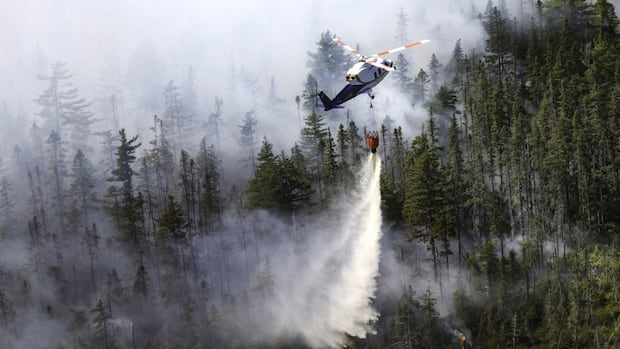The Long Lake wildfire in Annapolis County remains out of control and has grown to an estimated 1,977 hectares, according to the Nova Scotia Department of Natural Resources (DNR).
In an update posted to social media platform X just before 8 p.m. Sunday, the department said the wildfire had advanced past Godfrey Lake to the intersection of Fairns and West Dalhousie roads, near a number of homes that have been evacuated, and to the south side of Spectacle Lake.
The DNR said a large ground force of more than 200 firefighters — including 77 from the department, 120 local firefighters, 20 from Ontario and five from Prince Edward Island — were on the scene trying to save homes on Sunday night.
Two contracted helicopters were dropping water on the fire, and as of 7:45 p.m. local time, there were no reports of damage to any structure.
On Sunday afternoon, Scott Tingley, manager of forest protection for the DNR, said sprinklers, hoses and barriers were in place to protect houses in the area, but the fire was “within kilometres” of West Dalhousie Road.
Jim Rudderham, the province’s director for fleet and forest protection, said weather conditions weren’t helping matters, with winds moving the fire northeast toward West Dalhousie, where 107 homes were evacuated on Thursday.
“Today is very low humidity, and wind, and warm, and is everything we don’t need for helping us put out fires,” Rudderham said.
An earlier update from the DNR said that “more evacuations possible,” but as of 8 p.m., no more evacuation orders had been issued. The next update will be delivered on Monday morning, the department said.
The Long Lake wildfires complex has grown to an estimated 1977 hectares. It has advanced past Godfrey Lake to the intersection of Fairns and West Dalhousie roads on one side, and to the south side of Spectacle Lakes on the other. 1/3 <a href=”https://t.co/jDH69Ul5GD”>pic.twitter.com/jDH69Ul5GD</a>
—@NS_DNR
Four water-skimmer aircraft from the Northwest Territories were in use earlier, but were diverted to knock down a new fire at Simonds Lake in Digby County on Sunday night. The planes have returned to base for the evening, the department said.
In a news release on Sunday afternoon, the federal government announced it has approved a request for assistance from Nova Scotia.
The full extent of the resources that will be deployed is not yet known, but Eleanor Olszewski, the federal minister of emergency management and community resilience, said the government is working with the Canadian Armed Forces and other partners to “ensure Nova Scotia has the support it needs.”
According to Patricia Jreige, spokesperson for Nova Scotia’s Department of Emergency Management, the province asked Ottawa for permission to use CFB Greenwood to land and refuel the four skimmer planes that have arrived from the Northwest Territories.
Evacuees allowed to briefly return home
Over the weekend, evacuees were allowed to briefly return home with an escort to pick up clothes and grab essential items like medications.
Dustin Enslow, the deputy warden of the Municipality of the County of Annapolis, said Sunday that most of the 215 people affected are staying with family and friends, but others have been camping.
A community shelter at the Nova Scotia Community College campus in Middleton remains open, but Enslow said nobody has stayed overnight so far.
He said the municipality is exploring further support.
“We know that this is going to to continue for longer than what we wish, and as things progress, we will be adapting our plan and the supports available for individuals,”Enslow said.
‘Hot, tiring, hard work’ for firefighters
Rudderham said the firefighters’ morale is a mix of “happiness and sadness” as they take on this “hot, tiring, hard work.”
“I think a lot of them are proud to do the work they’re doing,” he said. “They’re going to soldier on and do the work that needs to be done.”

Rudderham said Friday’s helicopter accident at the fire scene is weighing on the group. He said the pilot, who was found conscious and taken for medical attention after his helicopter went into a shallow lake, is a friend of many of the firefighters.
Nova Scotia Power said Sunday evening that in order to support firefighting efforts, it may need to temporarily turn off power in the Morse Road area so first responders “can work safely around our equipment.”
It cautioned that a power outage does not mean a home is at risk or that evacuation is required.
There are 15 wildfires in the province. Long Lake, which started on Wednesday, is the only one listed as out of control.
The DNR’s Tingley said that while rain in the forecast for Sunday would be appreciated, it won’t be nearly enough to make a measurable impact.

Smoke around the province
Many Nova Scotians woke up on Sunday to heavy smoke, prompting some fire departments in the province to urge residents to remain calm.
“This morning with the cooler temperatures, the cold air actually pushed the smoke down to the ground and into the [Annapolis Valley],” said Chad Schrader, deputy chief for the Wolfville Fire Department. “The smoke was quite bad to the point where people thought there was a closer wildfire burning.”
In a social media post, the fire department says if smoke appears widespread or hazy throughout the area rather than forming a distinct column, it is likely drifting in from ongoing fires and does not require an emergency call.
Emergency calls should be made if there is a clear column of smoke, visible flames or a concentrated area of heavy smoke that appears local, it says.
The department says residents should call if smoke is coming directly from a building, vehicle or nearby wooded area, or if they believe there may be an immediate fire threat.
Environment Canada’s Air Quality Health Index forecasts a low risk around the province but notes the possibility of moderate risk in some areas due to the smoke.







